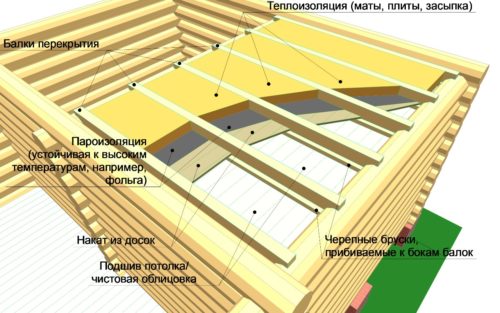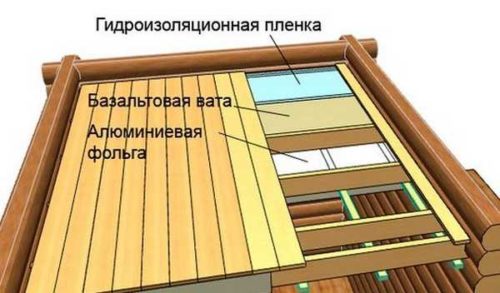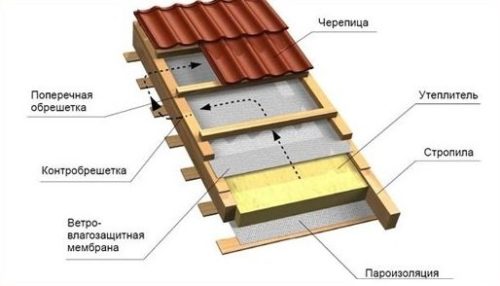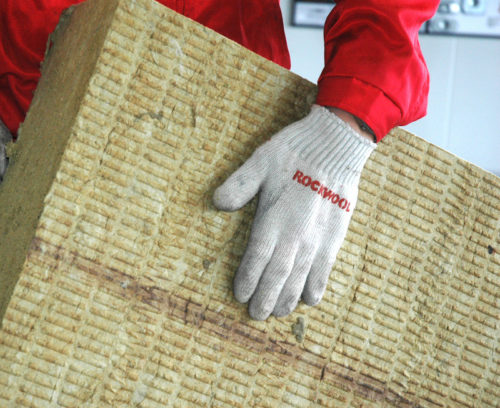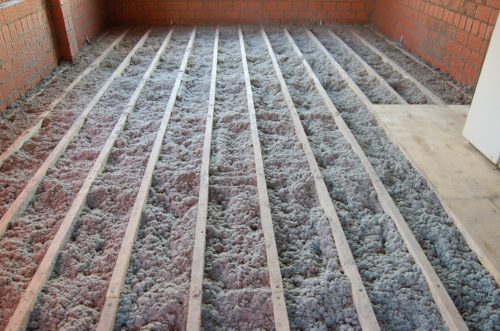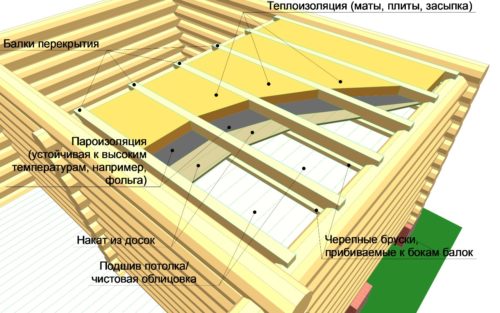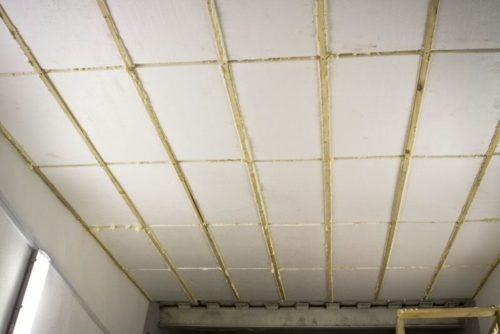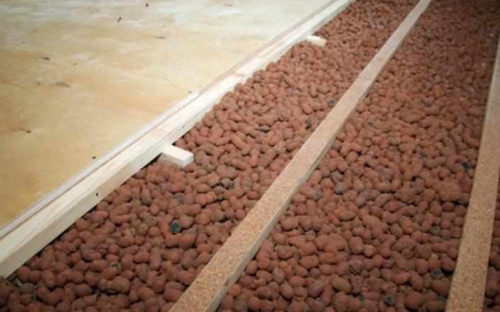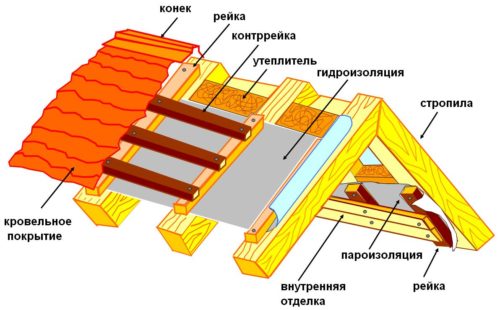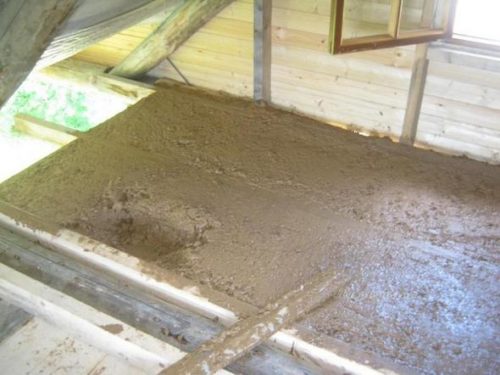As you know, the bathroom must fulfill a specific mission, so it is necessary to build it, adhering to certain requirements and rules. Since warm air is capable of climbing up, it is necessary to equip the insulation of the top of the bath in such a way that the heat does not go beyond the placement, but remained inside. Special attention should be paid to the insulation of the roof and the ceiling of the bathroom. At the same time, the heat insulation of the ceiling must be equipped so high-quality so that not only did not leave the warm air, but also did not accumulate the condensate surface. Next, we will tell about how to choose and install the insulation for the bath.
Content
- Heaters for the roof
- Airways for the roof of a bath
- Penoplex for roof insulation bath
- Stone wool plates for roof insulation
- Bath Roof Heater - Eco
- Fenosa with roof insulation bath
- Polyfoam for insulation roofing bath
- Glasswater for roof insulation bath
- Mineral insulation URSA for a bath
- Ceramizite for the insulation of the roof of a bath
- Clay, sawdust and reed for bleat insulation
- Heavy insulation roof in the bath
- Installing the insulation in the bath: video
Heaters for the roof
The modern building materials market offers a lot of options suitable for ceiling insulation. However, each insulation has its advantages and disadvantages, while not all of them are suitable for a bathroom. Consider all the available options for the insulation for the roof, as well as their advantages and disadvantages.
Airways for the roof of a bath
Mineral wool with a foil side (basalt fiber). Most often used for the insulation of the roof of bathrooms. It is environmentally friendly and harmless material, while possesses good thermal insulation characteristics. The material contains such natural rocks such as limestone and basalt. Plates of mineral wool, a layer of 15-20 cm fit into a chess order under roofing flooring.
The advantages of mineral wool with a foil side:
- Excellent thermal insulation qualities.
- High resistance to fire. Therefore, this material can be used to insulate the ceilings in the steammers.
- Gigroscopicity. Mineral wool plates are able to absorb and absorb excessive moisture.
- Long service life.
Penoplex for roof insulation bath
Plates "Penoplex". It is not recommended to apply in the departments of the wage, since the material does not withstand the temperature rise of over 70-75 degrees. Therefore, the plates of "Polymplats" are stacked only in the prebates.
Among the advantages of "Polystone" for the bath can be allocated as follows:
- Good resistance to elevated moisture level.
- Easy installation.
- Excellent heat and vaporizolation qualities.
- High density of material (1.5 times higher than that of polystyrene foam).
Stone wool plates for roof insulation
Rokwool (Stone Wool Plates) - are natural material. It is manufactured on modern melting technology in the centrifuge.
Among the advantages of stained wool plates are to highlight:
- Fire safety. Resistance to elevated temperatures. Therefore, this material is suitable for the insulation of the roof of bathrooms.
- Excellent thermal insulation qualities.
- Good sound insulation properties.
- Ecology.
- Long service life.
Bath Roof Heater - Eco
Equouthat. This material is considered environmentally friendly and safe. Its composition contains natural wood fibers. In its appearance, the plates of this material are similar to mineral wool plates, however, the properties of these insulation are different. For example, unlike minvati, an eco-star should not be used as a heat insulator for bathrooms, as it does not have the desired hygroscopicity. However, eco-plates, given their operational characteristics, will become excellent thermal insulators for residential buildings. The only, their installation is somewhat difficult for an inexperienced builder and requires the use of special equipment.
Among the advantages of eco-houses are worth highlighting:
- Acceptable price.
- Excellent thermal insulation qualities.
- Ecology.
Fenosa with roof insulation bath
Penosop. This is a "budget" version of the insulation for a bath. Among the advantages of this material it is worth highlighting the following:
- Good fire resistance.
- Good sound insulation properties.
- Low price.
- Stability to deformation.
Polyfoam for insulation roofing bath
Styrofoam. Like mineral wool slabs, foam plastic is very often used to insulate the roof of bathrooms. This material is considered an excellent option, based on the ratio of "price and quality" of the product. It is necessary not only for insulation, but also to arrange pair-insulation roofing in the bath.
Among the advantages of this insulation, it is worth highlighting the following:
- Good resistance to elevated moisture level.
- Not bad waterproofing properties.
- Easy installation.
- Excellent heat and vaporizolation qualities.
- Does not give shrinkage over time. Therefore, it is possible not to fear that a few years in the roof of your bathroom will appear gaps.
- Since the width of the material is small (5-6 cm), it is possible to significantly save the useful area of \u200b\u200bthe room, especially if the installation passes in small baths and parilots.
Disadvantages of foam:
- When installing the joints between the plates need additional processing of mounting foam.
- A high probability of acquiring poor-quality material, especially if cheap plates are bought.
- It is capable of separating toxic substances during melting.
- Little service life (up to 20 years).
- A fungus and mold can appear on the plates of foam.
Glasswater for roof insulation bath
Glasswater has good thermal insulation properties. In its appearance, the plates are glass gambles similar to the layers of mineral wool. However, the composition of the insulation data is different. So, the fiberglass is based on fiberglass, which is manufactured from the remains of natural sand and waste glass industry. Not suitable for insulation of bathrooms.
The advantages of this material include:
- Acceptable price.
- Easy installation.
- Not bad thermal insulation qualities.
- Good sound insulation properties.
- Small weight material.
The disadvantages of the material are as follows:
- When operating the material, small glass dust can be formed, which is dangerous to health, when entering the skin and mucous membranes.
- Installation should be carried out only in the presence of protective clothing.
- From the outer sides, the plates of glass wool should be closed by another material in order to prevent glass dust to the room.
Mineral insulation URSA for a bath
The most popular material in the URSA mineral insulator group is considered to be the terra insulation. It has excellent thermal insulation qualities, resistant to elevated levels of humidity, has quite high rigidity and strength. This material is suitable for the thermal insulation of the roof of the bath and private houses.
Ceramizite for the insulation of the roof of a bath
Ceramzite is often used to insulate the roof of the bath. This material has many weighty advantages:
- Ecology. This material is natural and absolutely safe to health.
- Excellent thermal insulation qualities.
- Easy installation.
- Good sound insulation properties.
- Long service life.
- Fire safety.
- On the surface of the material during its operation, harmful bacteria and microorganisms do not accumulate.
Clay, sawdust and reed for bleat insulation
Very often, for insulation, the roof of the bath is used - clay, sawdust and reed. These materials are natural. It is often used for insulation a combination of these materials, for example, clay is combined with sawdust, reed or straw. If you adhere to the correct technology of laying these natural insulation, you can provide a bathroom with good pair and thermal insulation.
Heavy insulation roof in the bath
Warm the roof of the bath foam
To carry out installation work, we will need:
- foam plates;
- membrane film;
- wooden timber;
- fast mounting dowels;
- scotch;
- screws;
- level, roulette.
- electrolovka.
Procedure for work:
- Before starting the installation, it is necessary to process all the structural elements of the roof of the bath protective compositions that prevent rotting and fire material. Bruks and rafters are covered with antiseptics and antipirens.
- Next, you should decide on the form of the ceiling of the bath and draw on paper cutting. Important rules: The beams of the crates should be located on the design perpendicular to the direction of laying the main material. Moreover, the stoves of the plates from which the surface will be erected should fall on the middle of the beam.
- When the plan is drawn, begin with what we find the lowest point at the ceiling. From it we make a projection on the wall, it will be the minimum level of our design. If it is necessary to omit it, then from the tagged label omit the perpendicular and make the level of the ceiling level. Then a pencil with the help of the level make the same marks around the perimeter. It should be extremely careful.
- The labels are attached to 70 cm with increments, while the fastener length should be more beam thickness by 60-70 mm. For fasteners, use a dowel fast mounting. The main thing is to carefully measure the distance between the installed straps.
- Between the crate and the ceiling, foam plates. From above, the heat-insulating layer is coated with cement-sandy solution.
- Next should be equipped with a layer of vapor and waterproofing. For this, a membrane film is used. Installation of waterproofing on the roof is carried out directly on the roof rafters, before installing the crate. The canvas of the film are stacked with a small overlay on each other (approximately 20 cm). The joints between the films of the film are sicked with scotch.
- After installing wall bars, we begin the installation of the inner crate, given the rules below. So, if the ceiling is planned to omit no more than the height of the bar, then the material is attached to the main overlap with the help of a dowel. And if the design is lowered below, it is necessary to attach it using metal suspensions. Before starting the installation, it is recommended to pull parallel threads from the wall timber, for which they feed nails on them or screw the screws. Thanks to these threads, you can smoothly install an internal crate.
- Next, decorative coating on the ceiling of the bath is installed.
Warming Bath Glina
The order of work on the insulation of the clay ceiling of a bathroom:
- Initially, the working surface is cleaned of dust and garbage.
- Next, thin strips are nailed between the roof beams of the roof in a step of 20 cm.
- We are preparing a mixture for insulation. To do this, mix the clay with sawdust in the 2: 3 ratio. Add a small amount of water and mix well.
- Then lay on the rails layer of polyethylene film. On the top on top, we embarked the layer of the mixture prepared before the mixture for insulation. It is important that the material layer is not too heavy and did not sell the film. It is enough to 70 mm thick layer of clay for the insulation of the ceiling of the bath.
- Next you need to give a prepared mixture to frozen. For this work is suspended for 10-15 days.
- When the clay mixture finally freezes, laid a layer of thin plywood sheets. From above, they are placed in aluminum foil.
Warming Bani Ceramzit
The order of work in this case is as follows:
- Initially, you should prepare a pillow of wooden boards for which the insulation will be laid. For this, boards are laid ceiling from the top and bottom.
- On the boards laid a layer of clay. In this case, the insulation should not be stirred with other materials (sand or straw), as it will lose its thermal insulation properties. The insulation layer should be no more than 300 mm.
- Top with a ceiling by boards.


